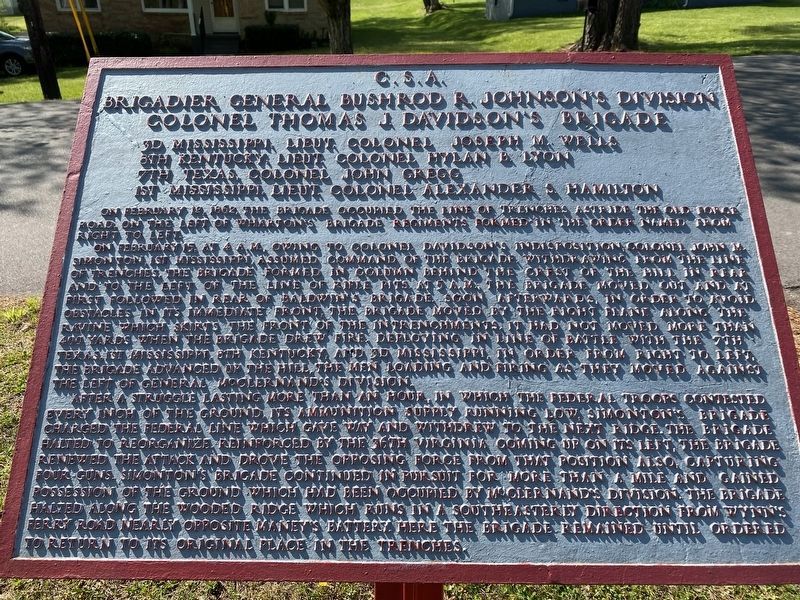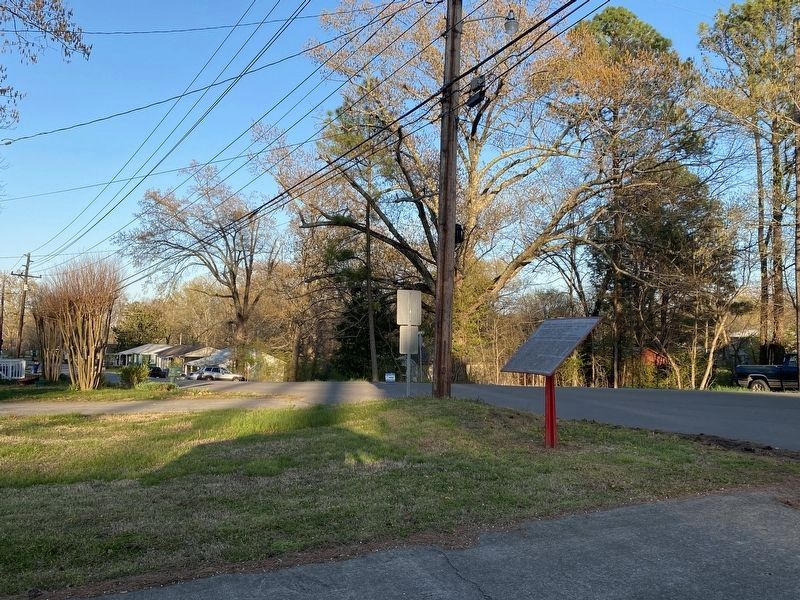Dover in Stewart County, Tennessee — The American South (East South Central)
Colonel Thomas J. Davidson's Brigade
Inscription.
C.S.A.
Brigadier General Bushrod R. Johnson's Division
Colonel Thomas J. Davidson's Brigade
3d Mississippi, Lieut. Colonel Joseph M. Wells
8th Kentucky, Lieut. Colonel Hylan B. Lyon
7th Texas, Colonel John Gregg
1st Mississippi, Lieut. Colonel Alexander S. Hamilton
On February 12, 1862, the brigade occupied the line of trenches astride the Old Forge Road, on the left of Wharton’s Brigade regiments formed in the order named from right to left.
On February 15, at 4 A.M., owing to Colonel Davidson’s indisposition, Colonel John M. Simonton, 1st Mississippi, assumed command of the brigade, withdrawing from the line of trenches. The brigade formed in column behind the crest of the hill in rear and to the left of the line of rifle pits. At 5 A.M., the brigade moved out and at first followed in rear of Baldwin’s Brigade. Soon afterwards, in order to avoid obstacles in its immediate front, the brigade moved by the right flank along the ravine which skirts the front of the intrenchments. It had not moved more than 400 yards when the brigade drew fire. Deploying in line of battle with the 7th Texas, 1st Mississippi, 8th Kentucky, and 3d Mississippi, in order from right to left, the brigade advanced up the hill, the men loading and firing as they moved against the left of General McClernand’s Division.
After a struggle lasting more than an hour, in which the Federal troops contested every inch of the ground, its ammunition supply running low, Simonton’s Brigade charged the Federal line which gave way and withdrew to the next ridge. The brigade halted to reorganize. Reinforced by the 36th Virginia coming up on its left, the brigade renewed the attack and drove the opposing force from that position also, capturing four guns. Simonton’s Brigade continued in pursuit for more than a mile and gained possession of the ground which had been occupied by McClernand’s Division. The brigade halted along the wooded ridge which runs in a southeasternly direction from Wynn’s Ferry Road nearly opposite Maney’s Battery. Here the brigade remained until ordered to return to its original place in the trenches.
Topics. This historical marker is listed in this topic list: War, US Civil. A significant historical date for this entry is February 12, 1862.
Location. 36° 28.864′ N, 87° 50.28′ W. Marker is in Dover, Tennessee, in Stewart County. Marker is on Natcor Drive just east of Main Street, on the left when traveling east. Touch for map. Marker is in this post office area: Dover TN 37058, United States of America. Touch for directions.
Other nearby markers. At least 8 other markers are within walking distance of this marker. Brown's Brigade (about 400 feet away, measured in a direct line); Greene's Battery (about 500 feet away); Texas (about 600 feet away); Planning to Escape (about 600 feet away); McCausland's Brigade (about 600 feet away); Forrest's Cavalry (approx. 0.2 miles away); Baldwin's Brigade (approx. ¼ mile away); Original Position (approx. ¼ mile away). Touch for a list and map of all markers in Dover.
Also see . . .
1. Fort Donelson. National Park Service site. (Submitted on June 8, 2020, by Byron Hooks of Sandy Springs, Georgia.)
2. Battle of Fort Donelson. Battle of Fort Donelson was fought from February 11–16, 1862, in the Western Theater of the American Civil War. The Union capture of the Confederate fort near the Tennessee–Kentucky border opened the Cumberland River, an important avenue for the invasion of the South. The Union's success also elevated Brig. Gen. Ulysses S. Grant from an obscure and largely unproven leader to the rank of major general, and earned him the nickname of "Unconditional Surrender" Grant. Source: Wikipedia (Submitted on June 8, 2020, by Byron Hooks of Sandy Springs, Georgia.)
Credits. This page was last revised on April 3, 2021. It was originally submitted on April 18, 2020, by Darren Jefferson Clay of Duluth, Georgia. This page has been viewed 251 times since then and 12 times this year. Photos: 1. submitted on May 14, 2020, by Darren Jefferson Clay of Duluth, Georgia. 2. submitted on April 3, 2021, by Darren Jefferson Clay of Duluth, Georgia. • J. Makali Bruton was the editor who published this page.

